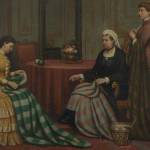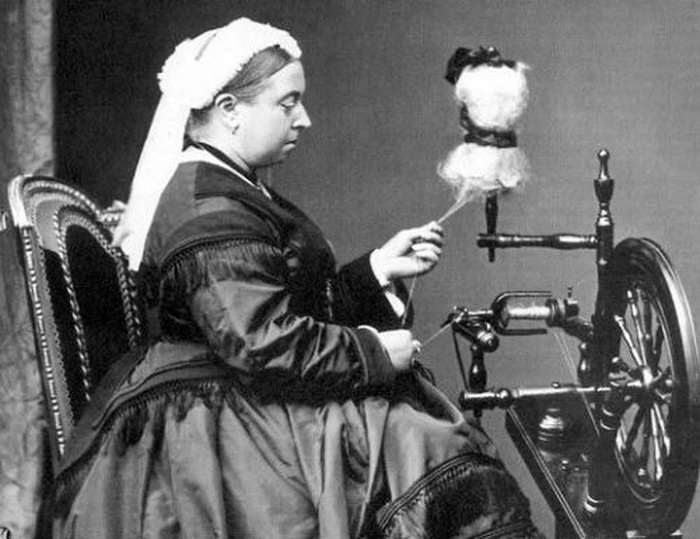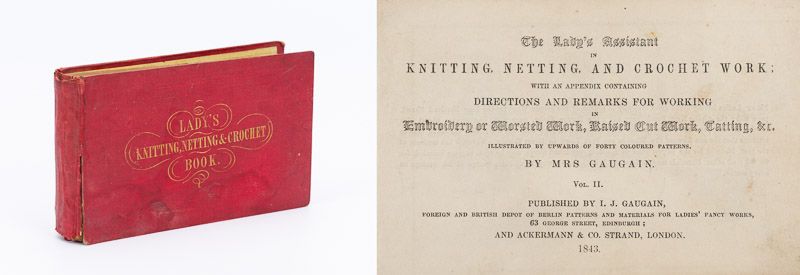Inspiration
Knitting Domestic Life, Victorian Style


In a drawing room that smells faintly of beeswax and boiled cabbage, a woman sits by the window with her knitting. The needles make their small music—click, click, pause, click again—like a metronome marking out the tempo of her day.
Beyond the glass, life is charging full pelt into the modern age, steam and soot and all, but here in the parlor, time seems to slow. Knitting has become something far more than a way to keep warm. It’s a signifier: of patience, virtue, feminine grace. A sort of domestic halo, spun in wool.
The Victorians were excellent at turning the ordinary into something deeply moral. Their drawing rooms were not just for sitting; they were showcases of taste and refinement. A flower arrangement wasn’t just decorative, it demonstrated one’s discernment and housewifely discipline.
Similarly, knitting, once practical and often public, done in fields, fishing boats, and cottages by men and women alike, was rebranded as an appropriate feminine pursuit, tucked safely indoors and filtered through layers of gentility.
By the mid-19th century, knitting had shifted from necessity to virtue, a domestic performance piece for the middle-class woman striving to embody the ideals laid out by Coventry Patmore’s “The Angel in the House.”
Patmore’s poem, syrupy and restrictive in equal measure, painted the ideal woman as self-sacrificing, docile, and ever devoted to home and hearth. Knitting, with its associations of diligence, economy, and quiet purpose, became the perfect prop.
To the outside eye, it might have looked like leisure: harmless, ornamental, perhaps even quaint. But in truth, the needles carried weight.
In a world where a woman’s moral standing was measured by her behavior within the domestic sphere, knitting became a kind of character witness. Good women made things. Patient women counted stitches. Modest women did not squander their time in idle amusement, but turned it into lace-edged baby bonnets and shawls so fine they could be pulled through a wedding ring.
This transformation wasn’t accidental. It was written literally into the patterns by a group of determined women who helped shape the domestic knitting boom. Jane Gaugain, often described as the “mother of modern knitting,” published The Lady’s Assistant for Executing Useful and Fancy Designs in Knitting, Netting, and Crochet in the 1840s.
Her books didn’t just offer patterns; they created a whole new language of knitting notation, and made the craft both accessible and aspirational for the burgeoning middle class. Gaugain’s success was no fluke. Her books were reprinted in multiple editions, crossing the Atlantic to influence American knitters too.
Then there was Frances Lambert, “needlewoman in ordinary” to Queen Victoria, a job title so magnificently Victorian it almost needs its own calling card. Lambert’s Handbook of Needlework blended practical instruction with appeals to taste, refinement, and moral improvement. She reinforced the idea that making something by hand wasn’t just industrious—it was virtuous.
Cornelia Mee was part of this influential trio. Her books weren’t only rich in designs, they also introduced readers to lesser-known techniques like Tunisian crochet and helped push needlecrafts into the realm of the fashionable. These were not women writing idle pastimes for idle hands; they were educators, taste-makers, and, in their own right, early entrepreneurs.
All this was unfolding at a time when the very need for hand-knitting was dwindling. The Industrial Revolution had spun its way into the fabric of daily life, and machine-made hosiery and outerwear were not only cheaper but more uniform. Yet knitting persisted, not as economic necessity, but as moral balm.

Queen Victoria engaged in another of the domestic arts.
Here lies the quiet paradox: even as Victorian society tried to shrink women’s world to the circumference of the parlor rug, knitting gave them a sense of agency within that confinement. To create something by hand was to make visible proof of your labor. It was a private act, but one with public meaning. A well-knit stocking wasn’t just practical, it was political, in its own under-the-radar way.
For women constrained by layers of lace and social expectation, the act of knitting offered something precious: autonomy. It was one of the few places where a woman could set her own pace, follow her own pattern, and sometimes go off-script.
Though the parlors have central heating now, and we are (mostly) no longer judged on our sampler skills or the neatness of our buttonholes, some of that Victorian legacy lingers. The idea that knitting is inherently wholesome, or that a knitter is necessarily calm, nurturing, domestic is still in the cultural wool, however subtly spun.
Today’s knitters, armed with Ravelry accounts and ergonomic needles, may not see themselves as inheritors of that particular legacy. But the echoes persist. Every time someone picks up their knitting in a waiting room or on a train, they are knowingly or not looping themselves into a longer history. The “angel in the house” might have folded up her lace shawl, but her influence still tugs gently at the edge of our projects.
Love this article? We love bringing it to you! MDK’s free daily content is made possible by your purchases from the MDK Shop. Take a look around. Browse our Sale page here. Thank you!



I so enjoyed this article. I would very much love to hear your thoughts on Tom Daley. I watch a video of his going though his yarn closet deciding what to take to the Olympics. I am impressed that he seems to knit without any pattern and his color selections are crazy.
yes!
I loved your article! I love feeling connected with the art of knitting that has been passed from generation to generation –
Great post. So enjoyed learning about these women. Now thinking of making business cards for myself with the title “Needlewoman In Ordinary”.
This was an excellent article! Well done!
Me, too! What a great title.
What a wonderful article, deftly weaving history and the present together, befitting of a knitter.
I like that
Well written. Understanding the past allows you to appreciate today.
Very interesting and soul stirring!
So enjoyed article can relate as I too carry bag of knitting where ever going. Watching people distance watching or asking brings smile.
I wouldn’t quite say that women’s worlds were shrinking – only the wealthy and rising middle class had time for the leisure activities promoted in Godey’s, etc., their leisure activity was created by their household of servants, many female, who did not have time for such activities, nor did those living in poverty.
The proliferation of patterns in women’s magazines did illustrate much craft as well as stories, etc. but the audience wasn’t the factory worker.
And the last part of the ‘Victorian era’ gave rise to the Suffragist movement, and changes in property and divorce laws.
Sadly, today people don’t replace buttons, they throw the garment out and buy a new one. Most don’t know how to even sew one on (knitters do though!). Many garments in earlier times were remade and repurposed.
“…only the wealthy and rising middle class had time for the leisure activities promoted in Godey’s, etc., their leisure activity was created by their household of servants, many female, who did not have time for such activities, nor did those living in poverty.”
Agree. For every “Angel in the House” lauded by Coventry Patmore, there were thousands like the desperate needleworker in Thomas Hood’s “Song of the Shirt,” and tens of thousands whose spinning and knitting were done not in cozy parlors but in the mills of Manchester and Massachusetts. Let’s give a thought to them as we read this interesting article about the fortunate minority.
and those who did ‘piecework’ – even in America into the 20th c. Or worked the looms.
Perhaps cue Elizabeth Gaskell instead of Coventry Patmore.
Fortunate Minority indeed.
Absolutely wonderful article, although it makes me NOT want to knit in public as an act of rebellion.
For anyone who needs a counterpoint to Coventry Patmore’s nausea, I highly recommend a book titled The Bitch in the House. It’s a collection of short pieces by various authors on the political, social and cultural restrictions that still impact our lives
“We are (mostly) no longer judged on our sampler skills or the neatness of our buttonholes.” Ha, I am glad you added the parentheses, Ashleigh-ellan. Some of us enter our knitting in county and state fairs, and we are JUDGED!
I encourage all of you to plan a late August trip to the Twin Cities to attend the Minnesota State Fair. The quality of needlework of all kinds is astonishing, dare I say jaw-dropping. I know my own finishing skills have improved enormously in pursuit of a ribbon or two.
Your comment reminds when I was recovering from surgery many years ago, I pulled out a crocheted table runner I had started and finished it as I laid on the sofa. I decided to enter it into our local fair. As I was taking it to be entered I was amazed at all the beautiful handwork people were bringing in. I thought I did not have a chance at a ribbon. It will just be fun I told myself. Imagine my surprise when I went back a few days later to see if I had maybe won a ribbon to find my table runner in a special case with a big judges choice ribbon laying on it!!
I love reading articles about the historical significance of knitting and how it has evolved. Thank you for writing this.
What a fun and educational read!! Thank you!!
Knitting was still an economic necessity for men and women during the 19th century, in Shetland, Scotland, England, Wales and Ireland knitted items were produced, often whole families were involved. Wales was known for its socks and stockings, Shetland for shawls and other items. The glove makers of the Dales in England were well known, as were so many other domestic providers of knitted goods up and down the British Isles. Not forgetting the Fisher Lassies, working in cold, wet, unhygienic conditions who knitted gansies for themselves, for sale and for their families. While the privileged women toyed with their fancy yarn, thousands of working women relied on their knitting to support their families.
Oh Heather that is so interesting what you’ve written there…
Between yours and others comments, including the original piece, thetes a book here!!… if someone could write it!…
Thank you
Great article! It did strike a chord, I still have a couple of magazines from the very early 1900s (belonged to my grandmother).
Very well-knit prose. Thank you.
Thanks for this article! However – it is mostly about the more distant past and only about certain places in the world.
Growing up behind the iron curtain, store bought clothing was limited in style, colour and often in sizes. My Mum knitted sweaters for me and my brother from old, frogged wool and those in turn were becoming new incarnations as we were growing out of them. I learned the how to’s from Her. The eight hour workdays and no weekends left little time for anything that was non-essential. Needless to say there was no time for lace or other fancy stitching (save darning or other repairs of course). When many years later I first encountered knitted lace I was astonished that you could actually knit something like that and also – patterns? Wow – why would you need a pattern at all? My Mum taught me the basics of course – a method you could call “by the seat of your pants”.
I was glad to notice that knitting as craft or hobby has experienced a renaissance in the late nineties and early oughts with the LYS’s returning to the neighbourhoods. But they are diappearing again (along with many yarn companies) and those that remain – mostly on internet are banding together – victims of new pastime: the very absorbing time thieves, the smart phones.
I wonder if we’ll live through another knitting renaissance in our life time?
Beautifully, beautifully written. Brava!
Fantastic piece of writing. Loved the implication that “what lies beneath” is usually most powerful.
Wonderful!
Loved reading this about past knitters gave me the urge to keep going with my knitting am losing the sight in my right eye but am sure I can keep knitting.
Although both of my grandmothers were born during Vicky’s reign and thus technically in the Victorian era this Anglo centric vision certainly didn’t fit them.
One was born in Tennessee in 1899. She didn’t knit, but did crochet. She liked to add a little lace trim to things, and made doilies.Her main needlework skill however was quilting. She even had a huge quilting frame that hung from the ceiling. She made many quilts but sold them usually. I have 2.
The other one was born in Finland in 1889. With 11 children, and living on a farm in northern Minnesota her knitting was definitely not an expression of her dainty female charms. All of her children, boys and girls were taught to knit while very young. She had sheep that were white, a neighbour woman had black ones and they shared yarn-or probably fleece–to have 2 colours.
One of the 2 photos we have of her shows her sitting in front of a little cabin with 2 other women: one is spinning, one is knitting and the other has a pile of fleece and those carding(?) blocks.
Very very interesting.
What a lovely article! I often think of topics like these when I step out of my harried life for a bit of knitting. I think of the historical constraints on women, or the lives of incredible manual labor they led and am amazed that they, after a grueling day of work, could sit down and knit. Not only did they create functional garments to keep their family safe and warm, but reached deep inside and found a well of creativity so that their creations were beautiful. I think if I can match their movement with hands, needles and yarn, maybe I’ll tap into their great wisdom and fortitude.
Thank you Ashleigh and all for this great article.
Great post! I’m taking it as encouragement to continue to knit in public instead of in my favorite seat.
Knitting is just so peaceful.
Very interesting and soul stirring!
Loved this. Thank you!
I read your story. I haven’t knitting an crocheting since I was 9. I have been spinning and teaching since 1982.
I love it. Had 22 sheep at one time. Now getting ready for the local farmers market. Go sell my wool. It made gorgeous yarn. I am going to print this info and let folks read it at the market. You are unique.
Thanks. What a great perspective to look at!
Thank you for this delightful connection to history in. Cynthia Coburn
I don’t know about knitting myself into the idea(l) of the Angel In The House.
I do know about how long one can be left hanging around when travelling in the UK by public transport. So a pair of socks is an ideal travelling companion – you have something to show for your journeys, you will have warm feet, and you won’t have sat their fuming and fretting because, in reality or metaphorically, they wheels have come off. Yet. Again.
Once you’ve mistressed the techniques, knitting socks can be a real stress-buster!
Well Witten Indeed
Thanks you so much
Thankyou for giving the history of knitting.